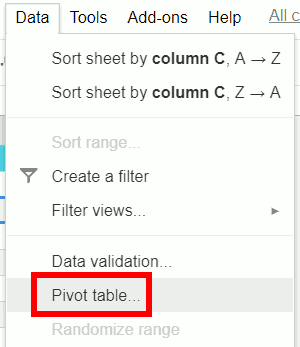Start with Good Data

The table of data in the image above is a good example of what makes good data for a Pivot Table. It has headers and the names of the headers describe the data that’s underneath it. The Sales Rep header is on a column that contains the names of the sales reps (duh). More importantly, there are no breaks in this data meaning that there are no blank lines. Also, the table is so large that you can’t just look at it and get the information. If the table of data was small, there could be no need for a Pivot Table since you could see all of your answers by eyeballing the data yourself.
Video Explanation
Create Your Pivot Table

Make sure that you have selected a cell within the source table of data, then go to the menu, choose Data, and Pivot table as shown in the image above. Use the OmniPivot add-on if you have more than one data range. Creating a pivot table gives you a blank slate that you’re going to work with. Sheets will “suggest” different Pivot Table configurations using artificial intelligence as shown in the image below. Unless you have very simple data and you want to have it summarized by one dimension, you are not going to guess what you want because there are so many different combinations. But, if you try one of these and click on it, it will build a table for you, which can be helpful if you have simple needs.

Add Data to the Pivot Table
Now we will start building out our Pivot Table. If we want to analyze the data by Sales Rep first and get the Sales Reps’ names going down the left-hand column, this is where it gets a little bit confusing, and it may be more clear to watch in the video. You want the Sales Reps names in the leftmost column, but you would like the name of each salesperson to be in a row. You need to add the Sales Rep for Rows even though these rows will be filling the first column. Sheets will fill them into the Pivot table in alphabetical order.
For the columns, you want the Ship Mode, and again, this is confusing. It’s going to be your row of headers, but each column is going to have the data in it so it’s called Columns. Let’s add the Ship Mode.


You’ll notice that each time you add a field, it asks if you want to show the totals. Let’s leave both checked, and there will be a Grand Total for the Sales Rep and a Grand Total for the Ship Mode.

The Values field will be what it shows you in the middle of your pivot table. For this table, we will look at the number of sales, not the dollar amount. Go to values and add our Sales column. It’s the field with the dollar amounts in it. Sheets defaults to summing dollar amounts. We want to count each of them as one, so we will change the function from SUM to COUNT.


Add the Dates
Now that we have Sales Rep and a count by each Ship Mode, the last thing we want to do is look at the data by year. Let’s have the dates on the left-hand side to the right of Sales Reps. Remember, this is called rows, even though it’s a column. Let’s add another row column, and we will make it the date.


Group the Dates
This isn’t what you want. We want it by year, but to do that, you had to add the dates. You can right-click on any of the dates, create a pivot data group, and select Year. More detailed information on how to summarize dates in a pivot table can be found here.

This is going to summarize the data by year because Google Sheets recognizes the data as valid dates. It can extract the Year and summarize by just that.

Filter by Date
Let’s say you’re just looking for 2018. Let’s go back to the right and scroll down to the filters. We’re going to add a filter for the date. It will be tricky how we’re going to do this. The drop-down says it’s showing all items. Select clear, type in 2018, and choose select all.


What we’re doing here is saying to unselect everything and show no dates. Then, if you type in 2018, it’ll show only the 2018 dates in the original table. If you click select all, it will only show the 2018 dates. Click OK. You have this filtered by 2018. Click OK, and there you are.
Completed Pivot Table
An easy-to-understand pivot table with just the data that you need, and if you want to change anything, this is always live. I could go back here and customize it however you like. So that’s all. Taking a good solid list of data that has columns with consistent data types in it, no blanks, and we’ve created this pivot table that gives you the exact information that you wanted to see.
More training is available on how to prepare data for a Pivot Table as part of a Pivot Table Course designed with beginners in mind.

0 thoughts on “Google Sheets Pivot Tables – Basic Tutorial”